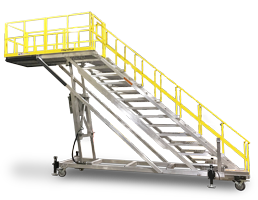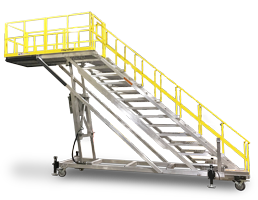3 Features That Will Save You Money With Your Cantilevered Work Platform
One of the most common access challenges technicians face, especially in manufacturing lines, is the need for cantilevered access at multiple levels. Because overreaching access requirements vary from project to project, cantilevered work stands have to be customized to the end user’s specs almost 100% of the time. Sometimes these requirements call for simply a “diving board” design that allows a technician to lie above a piece of equipment for access. Other applications, however, require a larger platform that has extensive overreach capabilities and can accommodate two or more technicians.

While there are plenty of cantilevered work platforms on the market that can hold multiple technicians at a time - the B Series platforms come to mind - the real challenge is finding a large overreaching work platform that provides vertical, cantilevered access without compromising on stability.
- 7 Steps To Buying The Perfect Custom Work Platform
- Four Methods Of Work Platform Actuation: Which Is Best For You?
- Q&A With KUKA Systems: Integrators Outsourcing Work Platforms
Below are the top three considerations you and your technicians should discuss before choosing a company to design and manufacture your cantilevered work platform.
1. Make sure the work platform is stable while in use.
Many existing cantilevered work platforms, by their very design, sacrifice stability due to extreme lengths of overreach from the foremost support points. Side to side sway, as well as “bounce” when working from the deck, increase the farther the platform is from the support points. Look for a work platform that is designed with the front leg support member as close to the center of the load as possible. This type of design allows greater overreach, as well as greater width of the work space, without the feel of instability. If necessary, add outrigger jacks to lock the stand in place and increase stability during use.
Look for a work platform that is designed with the front leg support member as close to the center of the load as possible. This type of design allows greater overreach, as well as greater width of the work space, without the feel of instability. If necessary, add outrigger jacks to lock the stand in place and increase stability during use.
Depending on the design, certain cantilevered work platforms will utilize counter-balance weights.
2. Choose a work platform with reliable actuation.
Hydraulic actuation has been a popular method of actuation for cantilevered work stands. But hoses and seals age and deteriorate, causing leakage of hydraulic fluid, and because of aging components, hydraulics have the tendency to “seep,” or slowly settle over time. This can create a significant problem when the stands are positioned above vulnerable components or surfaces. These issues increase maintenance costs, but also increase the likelihood of equipment damage during use.
Consider using a work stand that has electric or manual actuation. For example, the RangerMax work platform utilizes a dual-acting telescopic linear actuator system. This unique design provides greater extension capability while retracting into a compact length. The 120VAC or 12VDC electric actuators provide smooth, predictable extension and retraction, and cannot back-drive or seep from the set extension. These systems are also virtually maintenance-free.
Read a press release about the RangerMax Series here.
3. Ensure the work stand can be transported easily.
Users have found existing cantilevered work platforms are very difficult to maneuver in tight hangars and work areas, and it can be a struggle repositioning the work stand. Depending on your work environment, you might also be moving the stand over more rugged terrain, which can be nearly impossible if the stand isn't equipped with the right casters.
 For easy, manageable movement of your stand, look for a system that uses dual-disc casters. These casters allow easy movement of the platform both backward and forward and side to side, making positioning simple. Also check for a system that uses high-quality face brakes to secure the system during storage. If required, request outdoor-rated casters.
For easy, manageable movement of your stand, look for a system that uses dual-disc casters. These casters allow easy movement of the platform both backward and forward and side to side, making positioning simple. Also check for a system that uses high-quality face brakes to secure the system during storage. If required, request outdoor-rated casters.
Also, consider choosing aluminum. While aluminum is more expensive than steel, it’s roughly ⅓ the weight of steel, can be ribbed or extruded, and is corrosion resistant.
Additional Considerations
In addition to the above requirements, consider the following questions when sourcing your cantilevered access equipment:
- What is the lowest height at which you need your work platform to start? Many work platforms are designed with the lifting mechanisms underneath the deck, which limits its lowest height capabilities.
- How much cantilever capability do you need? There are various platform designs that provide cantilevered access, from a simple diving board design to the RangerMax stair with excessive overreach capabilities to a full-blown work platform with 24” or more of slider overreach. Do your research to make sure you’re finding the cantilevered access that fits your needs perfectly.
- What type of decking do you need? Consider if your technicians will be working on their knees a lot, or will have slick shoes, etc. Manufacturers can add specific high-traction or draining deck tread to make sure your work platform remains safe in all working conditions. You can also request deck matting for technicians that will be working on their knees.
- Keep it OSHA-compliant. Since you're getting an expensive piece of equipment, it should comply with OSHA's standards to eliminate any potential issues while in use. Look for a manufacturer that meets or exceeds OSHA's standards for mobile work platforms.
Looking for more types of work platforms?


